#detritus worm
Explore tagged Tumblr posts
Text
No fish in the 20 gallon yet, but we do have whatever is going on here
[Video id: Microscope video of a small white worm with a round head on aquarium glass. A comparatively enormous snail glides into view, eating algae. A tiny white copepod is also there, bouncing around.]
#*jaws theme*#aquarium#microscope#snail#bladder snail#aquatic snail#microbiology#detritus worm#bonus copepod!!!
5 notes
·
View notes
Text
The tentacle monsters in the jar on my desk enjoyed some flesh today! They seemed to really apriciate the treat.
#horror#i cant deal with aquarium maintnence#so i keep detritus worms in a jar and feed them table scraps#bugs#insects#worms#gross
23 notes
·
View notes
Text
This river jar ecosystem is insanely active at night! I kicked the lights on for some videos and it's worm city. At minimum 4 snails.

Would anyone be interested in more detailed photos with identifications?
Such as this whirligig beetle larvae. It took some deducing.

2 notes
·
View notes
Text
tbh im kinda surprised that nobody at work has picked up that in trans yet. Theres a small group who *knows*, but only because I specifically sought them out and told them. ive stopped going braless because now it just feels immodest walking in with c cups in a tight black t shirt. and yet nobody is any the wiser SOMEHOW. not one person has been like "yeah yknow i think somethings up with that [Jade] guy, always hanging around the womenfolk and using exclusively the unisex bathroom and sitting with his legs kicked up."
i had a suspicion they all knew and i was just clueless but one guy i told was like
"oh yeah i clocked you basically the second i met you"
"wait what for real?"
"yeah i was like 'Yup hes gay for sure'"
#its that stubble and the deep masculine voice i tell ya#and the fashion sense doesnt help either#another coworker said (in abridged terms) “you look so masculine. gives me rapey vibes”#which is a whole new can of worms i WILL explode open the second someone asks why i was SO mad abt that#the second i came out as bisexual everyone at work just neatly slotted me into the weird gay guy role#and they just write off any gender nonconformity as just normal gay guy stuff#I TAKE MY HORMONES IN THE BREAKROOM TOO#detritus
6 notes
·
View notes
Photo
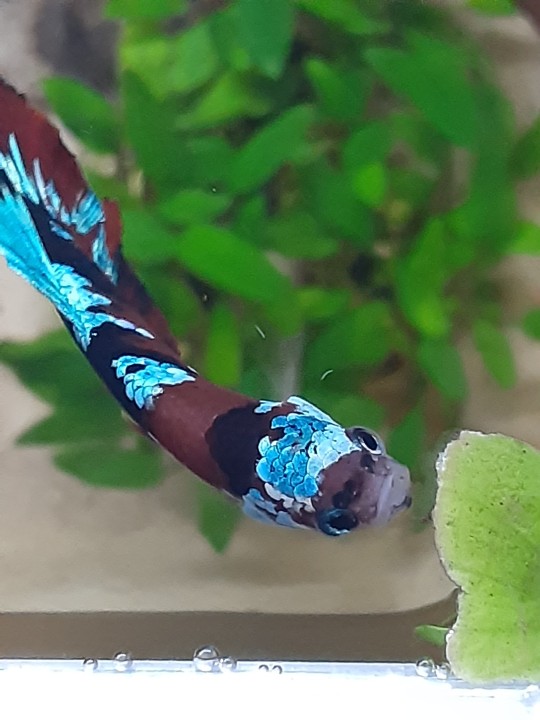
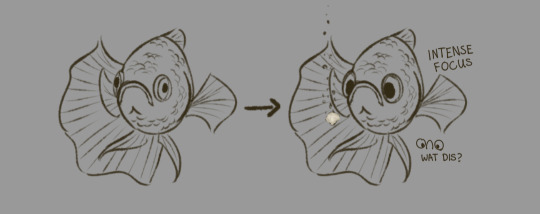
When bettas do The Thing™
Reblog if you agree :o
#ft khonshu doing the thing at a floating plant lmao#ignore the baby detritus worms floating near him#the tank finished cycling and an army of those things appeared#they're slowly going away#and hes eating the ones he sees#anyway#betta#betta splendans#fishblr
6K notes
·
View notes
Text
my shrinp had fucking BABIRS
#theyre SO TINY#theres still at least 3 berried moms so pretty soom ill have a whole shrimp daycare#the only problem is since ive been feeding them more spirulina and less pellets/wafers the detritus worm bopulation has grown :(#but once the babies get a little bigger that should take care of that problem#shrimp posting
1 note
·
View note
Text
Wet Beast Wednesday: Christmas tree worm
Merry Christmas from the ocean! For this festive occasion, I’ve chosen to cover an animal that certainly has the spirit of the season. The Christmas tree worm is the person who keeps their Christmas lights up all year of the sea and today we’re going to see what makes them tick.
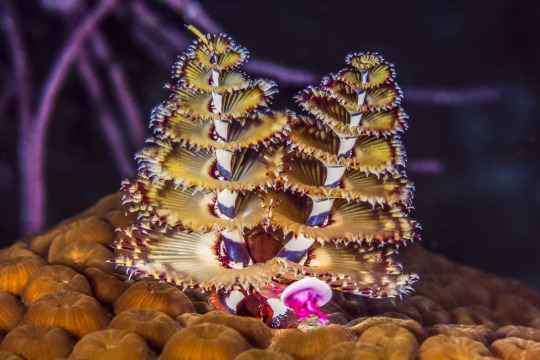
(Image: the crown of a Christmas tree worm. It appears as two stalks emerging from amongst coral polyps. Small feathery, appendages emerge from the stalks in a spiral formation going up them. They are yellow, with brown tips. A smaller, round structure is near the base of the trees. End ID)
The Christmas tree worm (Spirobranchus giganteus) is a polychaete worm of the tube-building fan worm clade Sabellida. While they are called giganteus, that’s only relative to other fan worms as they max out at about 3.8 cm (1.5 in) long. Being tube worms, they build a tube of calcium carbonate that they live in. This tube provides protection for the worm, who can retreat into it if threatened by predators. Polychaetes are defined by the paired bristle-like chaetes on each body segment, which are often used for locomotion. Tube worms like the Christmas tree worm lack these kind of locomotive appendages as they spend their entire lives in their tubes.

I couldn't find a full-body picture of a Christmas tree worm outside of its tube, so this is the best you get. (Image: Serpula vermicularis, a member of the same family of tube worms as the Christmas tree worm, removed from its tube. It is a short, segmented worm with a plug on a stalk and a crown consisting of long, feathery tentacles arranged differently than those of a Christmas tree worm. End ID)
The feature that gives these worms their common name is a pair of feathery, spiraling structures that emerge from the head and look quite a bit like tiny, colorful fir trees. These structures, called crowns, are heavily modified version of mouth appendages called prostomial palps. The feathery bits are tentacles called radioles. The crown is usually the only part of the worm visible, with the rest of its body safely in the tube. The crown is used both for feeding and respiration, as it can perform gas exchange with the water like gills. Christmas tree worms, like other fan worms, are filter feeders. They expose their crows to the water and wait for edible plankton and bits or organic detritus to get caught by the radioles. Cilia then transports the food down to the mouth. Christmas tree worms have a modified radiole called an operculum that acts like a lid to the front of the tube, closing it off when the worm retreats. The crown also has light-sensing structures, allowing it to detect light and shadow. The visual capabilities of these eye spots is poorly studied. The crown makes up about a third of the body length and can come in a wide variety of colors. It can regenerate if damaged.
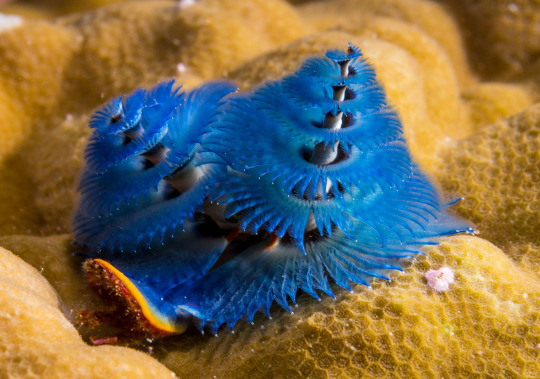
(Image: a blue-crowned Christmas tree worm emerging from yellow coral. End ID)
Christmas tree worms are found across most of the world, from the Caribbean to the Indo-Pacific, in tropical waters. They are coral reef dwellers who live in burrows built into had corals. Brain coral species are their preferred hosts, but they can live on other corals and have been reported living in sponges and on giant clams. Christmas tree worms certainly have a symbiotic relationship with the corals, it's debatable whether that relationship is parasitic, commensal, or mutualistic. They may damage nearby polyps and could spread harmful algae (that seems to be an open question), but I found sources suggesting they improve water flow around the coral, which could benefit it. When they sense a threat, the worms will rapidly retract into their tubes. Some time later (which can be seconds to minutes), they will cautiously emerge again. Worms living on crowded corals seem to be more timid, taking longer to emerge again. Christmas tree worms are broadcast spawners who release their gametes into the water. Fertilized eggs hatch quickly into larvae who must find their way to a coral and start their burrow. Christmas tree worms can live up to 30 years.
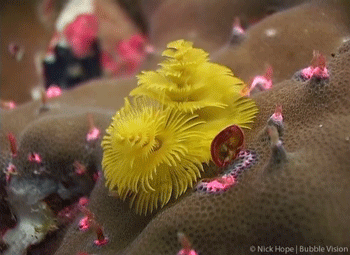
(GIF: a bright yellow Christmas tree worm retracting into its tube. The full retraction takes less than a second and leaves only a hole covered by the operculum. End ID)
Christmas tree worms are considered to have a stable population, but as they are dependent on corals, threats to reefs are threats to them. Thus, global climate change is a major threat to their survival. Predators of the worms include fish, starfish, and other worms. They are not of commercial interest to humans, but are popular among divers and have entered the aquarium trade.

(Image: multiple Christmas tree worms of various colors emerging from a coral. End ID)
#wet beast wednesday#christmas tree worm#wormblr#worms#worm#polychaete#annelid#invertebrates#invertiblr#coral reef#christmas#christmas tree#marine biology#biology#ecology#zoology#animal facts#informative#educational#image described
253 notes
·
View notes
Text
As someone who recently had to have hardware repair work done on both their laptop and their Switch Lite, sometimes part of (or even ALL of) the problem is something internal being accidentally pushed out of place by something, so the simple act taking part of it apart and putting it back together again lets the parts settle back where they're meant to be.
Regardless, congrats on accidentally fixing(?) your problem! :D
update. I opened the PC up, realized I didn't have a screwdriver small enough to move the cooler and actually have access to the bios so I gave up and connected it back ready for it to not work but it did??? i literally did nothing??? w waddei???
#My laptop problem was that the fan seemed to be acting up#and it turned out the reason the fan was acting up was because the battery had swollen (which was its own can of worms)#and was pressing up into the fan which in turn irreparably bent it and made it start spinning slightly off its intended axis#so I had to get BOTH replaced but after that it works perfectly fine.#My Switch Lite problem was that one of the joystick sensor pads stopped registering ''down'' input (common problem for the Switch Lite).#Typically the solution is to open up the system and gently clean off the pad since it's literally just a detritus buildup issue#but not only do I not have a screwdriver small enough for a First Generation Switch Lite#but I also wouldn't trust myself not to accidentally break the system itself if I did so OFF TO THE REPAIR CENTER IT WENT.#That said they techs also went the extra mile and replaced my worn-down sticks along with the pad so BONUS REPAIR lol.
25 notes
·
View notes
Note
We got any fun little worm dudes around?
I am going to interpret that to mean WORMS (inverts), so here you are...


Disguised as deep-sea acorn worms, two species of Yoda have been found– not so long ago, on a seamount far, far from land.
Yoda purpurata, discovered in 2012 with the ECOMAR ROV on the Mid-Atlantic Ridge, sports distinctly Yoda-like lobes on either side of its head (these are lips rather than ears). In 2022, scientists using Schmidt Ocean Institute’s ROV SuBastian found its North Pacific cousin. Yoda demiankoopi bears little resemblance to the original Yoda, but is still a force to be reckoned with. You try living off of tiny scraps of marine snow at the bottom of the ocean! Yoda purpurata: David Shale/Marinespecies.org Yoda demiankoopi © Schmit Ocean InstituteImages used under Creative Commons Attribution-Noncommercial-Share Alike 4.0 License
via: Woods Hole Oceanographic Institution
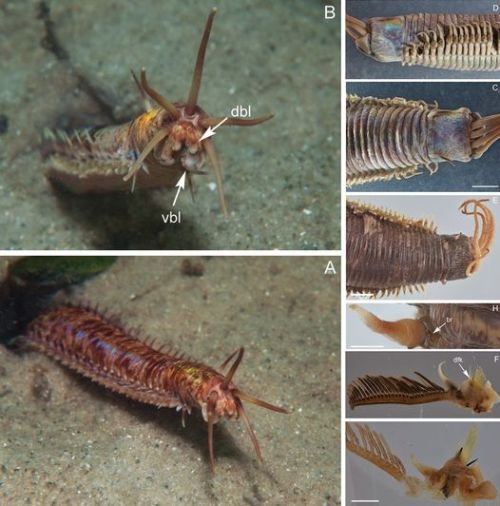
A new species of giant Eunice (Eunicidae, Polychaeta, Annelida) from the east coast of Australia
Read the paper here: https://zookeys.pensoft.net/article/86448/
youtube
Green Spoon Worm
Check out this freaky Green Spoon Worm (Metabonellia haswelli, phylum Echiura), filmed in Port Phillip Bay, Australia, on 8 Feb 2018. It may look harmless, but this marine worm can paralyze small animals using the neural poison in its skin.
via: Youtube.com
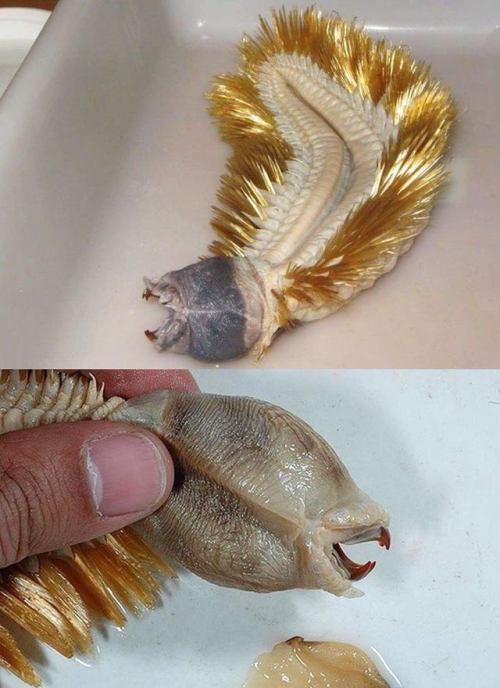
Say hello to Eulagisca gigantea, the golden worm from the Antarctic seas
from photographer Matthew Brown
It’s an Antarctic scale worm, a type of polychaete (bristle worm).There are many different species, all around the world, ranging in size, colour, and living habits. Some feed on detritus, others like this one, are predators. It’s laying on its back, those golden bristles are it’s feet, which it uses to walk along the soft sediments on the sea floor. Some species live in tunnels, those ones have greatly reduced spines. They’re a cool group of animals. Most of NIWA (National institute of water and atmosphere research) deep sea specimens like this are collected by their long range research vessel the Tangaroa. They had a lot of cool stuff, giant amphipods, isopods and giant squid etc. They’re basically trying to figure out biodiversity hot spots on the sea floor around the world in order to inform the establishment of marine sanctuaries. They also provide advice to fisheries about fish populations.
via: So Bad So Good
youtube
Weird and Wonderful: Green bomber worms drop bioluminescent “bombs"
Green bomber worms (Swima spp.) have specialized organs that explode with a burst of green bioluminescence. This impressive display is likely used to startle predators while the animal makes a speedy getaway. They live just above the seafloor and are vigorous swimmers, able to maneuver both backwards and forwards. Each worm carries up to eight “bombs.” If they lose one, they can grow it back. The “bombs” may have been gills that evolutionarily transformed over time. Although these worms lack eyes, they have developed a novel bioluminescent defense mechanism. MBARI research has shown that approximately three quarters of the animals living in the dark ocean depths are capable of producing bioluminescence.
Learn more about these amazing deep-sea worms:
https://www.mbari.org/new-species-of-deep-sea-worms-release-glowing-bombs/
270 notes
·
View notes
Text
Stede: what are you thinking about
Ed: I'm -
Ed: who says I'm thinking about anything? I'm just chilling here, minding my own business
Stede: okay but you had your thinking face
Ed: It's silly
Stede: I love silly!
Ed: awright
Ed: do you think, like. Do you think we're best friends in every universe? Do you think we always love each other?
Stede, without missing a single beat: I think so. I can't imagine knowing you and not loving you
Ed: awwwgh
Stede: my only regret is that it took us so long to find each other. But as far as I'm concerned, you've always been mine. I just had to find you
Ed: c'mon man you can't just say this shit
Ed: what if we were. uh. ponies
Stede: you hate ponies
Ed: yeah because of their - fucking creepy-ass eyes
Ed: but if I was a pony I probably wouldn't mind that
Stede: ooh what if you found human eyes creepy instead
Ed: that's not relevant to this thought experiment Stede. just work with me here. What if we were ponies
Stede: then we would frolic in the pasture together. and eat grass together. And I would steal extra sugar cubes straight from the farmer's pockets for you
Ed: what if we were birds
Stede: then we would fly together, and I'd find the best worms for you, and we would make a game out of shitting on bald guys' heads
Ed: what if we were something gross though. Like snails
Stede: well Ed. then I would delight in spending every day consuming detritus with you
Stede: oh no sweetheart don't cry
Ed: I promise I'll consume detritus in every lifetime with you Stede
244 notes
·
View notes
Text
Phylum Round 3

Annelida: Segmented Worms. This group includes earthworms, leeches, and many classes under the umbrella of “polychaete”. This diverse phylum encompasses deposit feeders (eating dirt), detritivores, scavengers, deadly ambush predators, filter feeders, parasites, herbivores, and more. They are broadly defined by their repeating body segments and parapodia, which are nubby appendages used for both movement and breathing. Some have curved jaws for catching prey or scraping detritus off of rocks, while others have wide, elaborate, brightly colored feather-like fans for filter feeding. While able to crawl freely, a majority of marine Annelids spend most of their time in self-built tubes or burrows. Among their many important functions, they play a key role in mixing soil/sediment, breaking down decaying organic matter, and providing a key food source to countless other animals.
Cnidaria: Jellyfish, anemones, corals, box jellies, and hydroids. They have a gelatinous body with radial symmetry, a decentralized nervous system, and tentacles surrounding a simple mouth. The defining feature of this phylum are their cnidocytes, or stinging cells. There are two different body plans of the Cnidaria; an immobile “polyp” attached to a surface, or a free-living “medusa” which can swim or drift in the water column. Many polyp Cnidarians, such as corals, live in colonies. Some corals build reefs which serve as habitat for other animals. Free-living medusa Cnidarians must return to the seafloor in a polyp-like stage as a part of their life cycle.
#annelida#cnidaria#animal bracket#tumblr bracket#bracket tournament#poll bracket#phylum round 3#phylum#begging on my knees for annelids rn sorry I am so biased#world's best most beloved worms
337 notes
·
View notes
Text
Uncharismatic Fact of the Day
Just because it looks like a worm, and crawls like a worm, doesn't mean it's a worm-- sometimes it's a worm slug! These gastropods are named for their strong resemblance to common worms; in particular their long, thin bodies and pink coloration. Also like worms, worm slugs are most commonly found underground, consuming bits of soil, detritus, or worm feces as they tunnel along.

(Image: A worm slug (Boettgerilla pallens) by Jozef Grego)
If you like what I do, consider buying me a ko-fi!
#worm slug#Heterobranchia#Boettgerillidae#slugs#heterobranchs#gastropods#mollusks#invertebrates#uncharismatic facts
157 notes
·
View notes
Text
right before i forget let's have some creature updates:
peppercorn is in an enclosre with a front opening panel now and every day his enrichment is worming his way against the corners in order to tear his thermometer down

apologies for the weird corner I'm zoomed in to like the leftmost third of his tank so it's reflecting my monitor from across the room
chao update: Loamf. cursing my bloodline with that stare i think.

isopod update: i have a hell of a busy next few days but I will but changing out some of the old detritus for a new set of leaves and handful of vegetable scraps, and will update with pics then
215 notes
·
View notes
Text
Round 2 - Chordata - Petromyzontida




(Sources - 1, 2, 3, 4)
Petromyzontida is a class comprising one order, Petromyzontiformes, commonly called “lampreys.”
Like their closest living relatives, the hagfish, lampreys bear a cartilaginous skull and rudimentary vertebrae. Adults lack a jaw, and are characterized by a toothed, funnel-like, sucking mouth. They have elongated, eel-like bodies reaching up to 1.3 metres (3.9 ft) long. They have one nostril atop the head, seven gill pores on each side of the head, two well-developed eyes, and two parietal eyes. Only 18 species are predators or scavengers, the rest (all freshwater species) do not feed as adults, instead living off the reserves gained as juveniles. Carnivorous species are marine, though 9 of them migrate into freshwater to breed. They use the suction cup around their mouths to cling to rocks or prey, using their tongue to either rasp blood from prey or algae from rocks. They also use this suction cup to climb up rocks when migrating upstream to breed.
Adult lampreys spawn in nests of sand, gravel and pebbles in clear streams. After hatching from their eggs the larvae, called ammocoetes, will drift downstream with the current until they reach soft and fine sediment in which to burrow, taking up an existence as filter feeders, collecting detritus, algae, and microorganisms (image 4). Their eyes are underdeveloped, only capable of discriminating changes in light. Lampreys spend the majority of their lives as these filter-feeding ammocoetes. Most species spend up to 8 years, though some may spend as little as 1-2 years. The ammocoetes will then undergo a metamorphosis which generally lasts 3-4 months, during which they do not eat.
The oldest fossil lamprey, Priscomyzon, is known from the Late Devonian. Other stem-group lampreys, like Pipiscius, Mayomyzon and Hardistiella are known from the Carboniferous. While they appear relatively unchanged, stem-lampreys lack the specialised, heavily toothed discs with plate-like laminae present in modern lampreys, and their larvae resembled the adults, rather than having a distinct stage. The earliest lamprey with the specialised toothed oral disc typical of modern lampreys is Yanliaomyzon from the Middle Jurassic.

Propaganda under the cut:
Many species change color as ammocoetes, becoming dark during the day and pale at night.
Lampreys have been extensively studied because their relatively simple brain is thought to reflect the brain structure of early vertebrate ancestors, thus providing insight into our origins.
Lampreys are valued as food in the Northwest United States, throughout Europe, in Russia, Japan, and in South Korea. King Henry I of England is claimed to have been so fond of lampreys that he often ate them, late into life and poor health, against the advice of his physician concerning their richness, and is said to have died from eating "a surfeit of lampreys".
In the county of Nakkila (Finland) and Carnikava Municipality (Latvia), the European River Lamprey (Lampetra fluviatilis) is the local symbol, found on their coats of arms.
The legend of the Lambton Worm from County Durham in North-East England concerns a lamprey being fished out of the River Wear by a young boy skipping church. He declares that he had “caught the devil” and disposes of it down a nearby well. Over the years, the lamprey grows into a giant, poisonous Worm, wrapping itself around a local hill and terrorizing the village. Hijinks and witch-curses ensue.
Lampreys were highly appreciated by the Ancient Romans, not only as food, but also as pets. Lucius Licinius Crassus was mocked by Gnaeus Domitius Ahenobarbus for weeping over the death of his pet lamprey, who he was said to have adorned with earrings and small necklaces, training it to respond to its name and swimming up to eat what was offered. Crassus retorted that Domitius had lost three wives himself and Crassus had never seen him shed a tear.
Publius Vedius Pollio was reportedly an exceedingly cruel Roman soldier who kept a pool of carnivorous lampreys to which he would feed slaves who had displeased him. This went on until Gaius Julius Caesar Augustus was visiting his mansion and witnessed Pollio about to dispatch a slave who had broken a crystal cup. Augustus had all of Pollio’s cups destroyed, as well as his mansion, and filled in his pond. This is likely an urban legend, but honestly, I feel like it should have ended with Pollio going down with the lampreys.
Dams and other human development have made it hard for lampreys to migrate upstream to breed. Some scientists are hoping to design ramps that will utilize lamprey’s climbing ability so that they can bypass dams.
#idk where the gif comes from so I’m sorry if it’s from something Problematic™#round 2#animal polls#chordata#petromyzontida
82 notes
·
View notes
Text
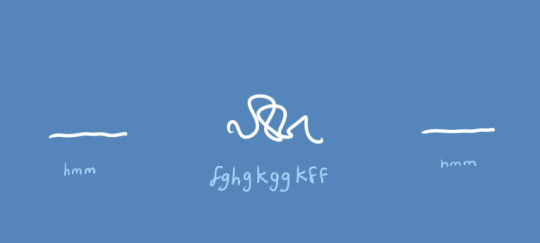
That video I just reblogged reminds me of the time I lovingly observed a stray detritus worm in my snail aquarium.
147 notes
·
View notes
Text
Animal of the Day!
Christmas Tree Worm (Spirobranchus giganteus)
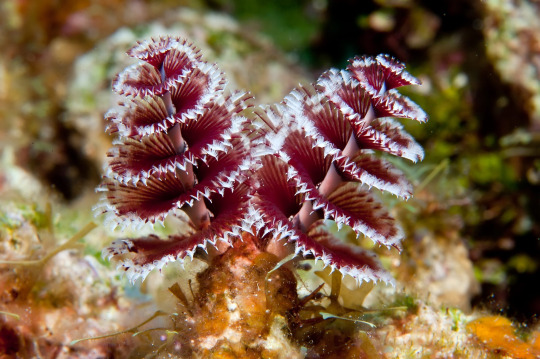
(Photo from Oceana)
Conservation Status- Unlisted
Habitat- Indo-Pacific Ocean; Atlantic Ocean
Size (Weight/Length)- 38 mm
Diet- Zooplankton; Detritus; Phytoplankton
Cool Facts- Upon first glance, you might think that the Christmas tree worm is a plant rather than an animal. The majority of the worm is actually buried in coral. They then build a complex tube around their soft body that serves as the worm’s forever home. The Christmas tree worm releases a pair of ‘crowns’ that is part of their mouth, sort of like a tongue. The appendages can be used for catching prey along with circulating water through their gills. When their ‘crowns’ retreat fully into their mouth, sharp spines are extended to further protect the worm from harm.
Rating- 13/10 (Symbiotic relationship with coral is still being researched.)
#animal of the day#animals#worm#marine worm#marine creature#wednesday#august 30#christmas tree worm#biology#science#conservation#the more you know
217 notes
·
View notes